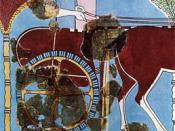Prehistoric Art:Palaeolithic cave art has been found through much of Europe and Africa. Its artists used mineral oxide pigments such as Black and Red Manganese and carved pictures into cave walls and ceilings to leave their mark. Initially, it was thought that since most of the depictions were of animals--cave paintings were part of Shamanic rituals to "draw in" the spirits of the animals being hunted so that they would be easier to catch. Interestingly, the bones of the animals had not been found in the area around the caves which carried the images of the animals. According to Dale Guthrie-author of The Nature of Palaeolithic Art "the animals most often represented in Palaeolithic caves are among the ones least frequently consumed as food" (White).Archaeologist Jean Clottes believes that upper-Palaeolithic cave images "were part of [the artists'] visions, the trances they had after staying in the dark of these caves."
His thoughts are comparable to those of author and anthropologist David Lewis-Williams, whose main belief is that the shamanistic religious practices of the modern-day hunter-gatherer societies parallel those of ancient nomadic tribes. Despite the separation of time, cave art of these tribes from merely a century ago matches the ancient cave paintings found in areas of France, Africa and so forth. Great parallels have been drawn between the images projected by the mind during times of sensory deprivation (such as complete lack of light as experiences in a cave) and the prehistoric images in caves (How art madeâ¦). A shoot-off of his theory is Caves or rocks generally were considered entrances or portals to the supernatural world.
Shamans isolate themselves in the cave and the darkness causes them to see images. Whichever animal the shape or image resembled that would be the animal drawn- often, Shamans drew images similar to...


